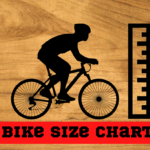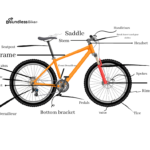When it comes to buying a bike, choosing the right frame size is crucial for a comfortable and efficient ride. One common question that arises is whether to go for a medium or large frame. The answer depends on several factors, including the rider’s height, inseam length, riding style, and personal preference.
Typically, medium frames are suitable for riders between 5’5″ and 5’10”, while large frames are best for those between 5’10” and 6’2″. However, this is just a general guideline, and riders should always test ride different sizes to find the best fit. A bike that is too small can be uncomfortable and cause strain on the back and knees, while a bike that is too large can be difficult to handle and control.
Why Bike Frame Size Matters
When it comes to choosing the right bike frame size, it’s crucial to get it right. A bike frame that’s too small or too large can cause discomfort, affect your posture, and even lead to injuries. Here are some reasons why bike frame size matters:
Comfort
A bike frame that’s the right size for you will provide you with comfort while riding. If the frame is too small, you’ll be cramped up, and your knees may hit the handlebars. On the other hand, if the frame is too large, you’ll have to stretch to reach the handlebars, which can cause back pain and discomfort.
Efficiency
A bike frame that’s the right size for you will allow you to ride more efficiently. If the frame is too small, you’ll have to work harder to generate power, and you’ll tire more quickly. If the frame is too large, you’ll have to work harder to control the bike, which can also lead to fatigue.
Safety
A bike frame that’s the right size for you will allow you to ride safely. If the frame is too small, you may lose control of the bike, especially when going downhill. If the frame is too large, you may not be able to control the bike properly, which can also lead to accidents.
How to Choose the Right Bike Frame Size
To choose the right bike frame size, you need to consider your height, inseam length, and riding style. The table below provides a general guideline for choosing the right bike frame size based on your height:
| Height | Bike Frame Size |
|---|---|
| 4’10” – 5’2″ | 13″ – 14″ |
| 5’3″ – 5’6″ | 15″ – 16″ |
| 5’7″ – 5’10” | 17″ – 18″ |
| 5’11” – 6’2″ | 19″ – 20″ |
| 6’3″ – 6’6″ | 21″ – 22″ |
Keep in mind that this is just a general guideline, and you may need to make adjustments based on your inseam length and riding style. It’s always best to try out different bike frame sizes before making a purchase to ensure that you’re getting the right size for you.
Determining the Right Bike Frame Size for You
When it comes to choosing the right bike frame size, there are several factors to consider. A bike that is too small or too large can lead to discomfort, pain, and even injury. In this section, we’ll explore how to determine the right bike frame size for you.
Measuring Your Inseam
One of the most important factors in determining the right bike frame size is your inseam measurement. To measure your inseam, stand with your feet shoulder-width apart and place a book between your legs, as if you were sitting on a saddle. Measure the distance from the ground to the top of the book. This measurement will give you an idea of the frame size that will be most comfortable for you.
Considering Your Riding Style
Your riding style is another important factor to consider when choosing a bike frame size. If you plan to do a lot of off-road riding, you may want a smaller frame size to make it easier to maneuver. If you plan to do a lot of long-distance riding, a larger frame size may be more comfortable.
Taking Your Body Proportions into Account
Your body proportions can also play a role in determining the right bike frame size. For example, if you have long legs and a short torso, you may need a larger frame size to accommodate your leg length. If you have a short inseam and long arms, a smaller frame size may be more comfortable.
To help you determine the right bike frame size, here is a general guide based on inseam measurements:
| Inseam Measurement | Frame Size |
|---|---|
| 27-29 inches | 14-15 inches |
| 29-31 inches | 15-16 inches |
| 31-33 inches | 16-17 inches |
| 33-35 inches | 17-18 inches |
| 35-37 inches | 18-19 inches |
| 37-39 inches | 19-20 inches |
| 39-41 inches | 20-21 inches |
| 41-43 inches | 21-22 inches |
| 43-45 inches | 22-23 inches |
| 45-47 inches | 23-24 inches |
Keep in mind that this is just a general guide, and you may need to adjust the frame size based on your riding style and body proportions. It’s always a good idea to test ride a bike before making a purchase to ensure that it feels comfortable and fits properly.
Medium vs Large Bike Frame
When it comes to choosing the right bike frame size, it can be challenging to decide between a medium or large size. There are pros and cons to both options, and it’s essential to understand them before making a decision.
Pros of a Medium Bike Frame
A medium bike frame is suitable for people who are between 5’5″ and 5’11” tall. Here are some benefits of choosing a medium bike frame:
- More maneuverable: Medium bike frames are easier to handle and maneuver, making them ideal for tight turns and quick movements.
- Lighter weight: Medium bike frames are generally lighter than larger frames, making them easier to ride for long distances.
- More versatile: Medium bike frames are more versatile than larger frames, making them suitable for a wide range of riding styles.
Cons of a Medium Bike Frame
While medium bike frames have their advantages, they also have some drawbacks:
- Less stable: Medium bike frames are less stable than larger frames, which can make them more challenging to ride at high speeds or on rough terrain.
- Less comfortable: Medium bike frames can be less comfortable for taller riders, as they may have to hunch over to reach the handlebars.
- Limited adjustability: Medium bike frames have limited adjustability, so it may be more challenging to make significant changes to the bike’s fit.
Pros of a Large Bike Frame
A large bike frame is suitable for people who are over 6’0″ tall. Here are some benefits of choosing a large bike frame:
- More stable: Large bike frames are more stable than medium frames, making them ideal for high-speed riding and rough terrain.
- More comfortable: Large bike frames are more comfortable for taller riders, as they allow for a more upright riding position.
- More adjustability: Large bike frames have more adjustability, allowing for greater customization and a better fit.
Cons of a Large Bike Frame
While large bike frames have their advantages, they also have some drawbacks:
- Less maneuverable: Large bike frames are less maneuverable than medium frames, making them more challenging to handle in tight turns or quick movements.
- Heavier weight: Large bike frames are generally heavier than medium frames, making them more challenging to ride for long distances.
- Less versatile: Large bike frames are less versatile than medium frames, making them less suitable for a wide range of riding styles.
In summary, choosing between a medium or large bike frame depends on the rider’s height, riding style, and personal preference. It’s essential to consider the pros and cons of each option to make an informed decision.
Factors to Consider When Choosing Between Medium and Large Bike Frames
When it comes to choosing the right bike frame size, there are many factors to consider. Choosing the right size is essential to ensure a comfortable and efficient ride. Here are some factors to consider when choosing between medium and large bike frames.
Height
Height is one of the most important factors to consider when choosing a bike frame size. A medium bike frame is typically suitable for riders between 5’5” and 5’10”, while a large bike frame is suitable for riders between 5’10” and 6’2”. However, this is just a general guideline, and riders should always test ride the bike to ensure a proper fit.
Weight
Riders who are heavier may need a larger bike frame to ensure the bike can support their weight. A larger bike frame will typically have a stronger frame and a higher weight capacity.
Flexibility
Riders who are less flexible may prefer a medium bike frame as it will have a shorter top tube, making it easier to reach the handlebars. A larger bike frame will have a longer top tube, which may be uncomfortable for riders who are less flexible.
Riding Conditions
The type of riding conditions will also play a role in determining the right bike frame size. Riders who plan to ride on flat roads or smooth trails may prefer a larger bike frame as it will provide a more stable ride. Riders who plan to ride on technical trails or steep hills may prefer a medium bike frame as it will be more maneuverable.
Personal Preference
Ultimately, personal preference will play a significant role in determining the right bike frame size. Some riders may prefer a larger bike frame for a more stable ride, while others may prefer a medium bike frame for a more maneuverable ride. It is essential to test ride the bike to determine which size is the most comfortable and efficient for the rider.
In conclusion, choosing the right bike frame size is essential to ensure a comfortable and efficient ride. Riders should consider their height, weight, flexibility, riding conditions, and personal preference when choosing between medium and large bike frames.
Also Read Do Titanium Bike Frames Break?







